- Screen Colours:
- Normal
- Black & Yellow
The Victorian period saw a flourishing of new statuary and sculptures adorning our towns and cities nationally, and Ipswich was no exception. In fact, the Cornhill can be viewed as an important outdoor art gallery with four stone female sculptures depicting the Victorian virtues of Commerce, Agriculture, Law and Order and Justice on the Town Hall, at parapet level above three roundels containing likenesses of our Cardinal and the two monarchs who gave charters to Ipswich. The former Post Office building displays four more female figures above its portico depicting the Victorian pride in its achievements of Industry, Electricity, Steam and Commerce, with another two female figures at rooftop level representing Genius and Science. A majestic lion looks down proudly upon the people of Ipswich from the roof of the former Golden Lion Hotel and Saint George and Queen Victoria grace either side of the entrance to Lloyds Bank on the north side of the space.
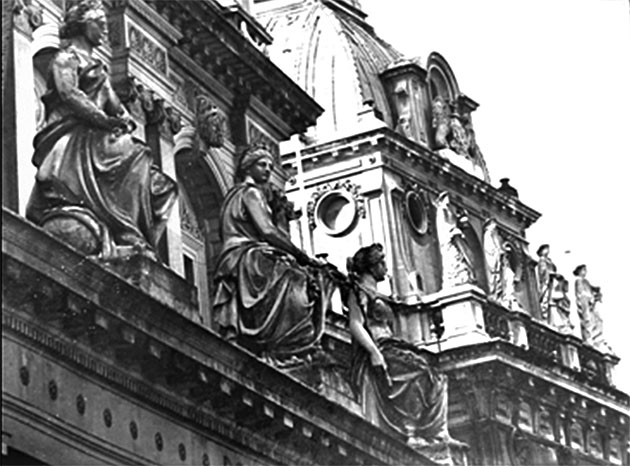
Above: Florentine Ipswich – 'The Cornhill as an important outdoor art gallery'.
This flourishing of public art was followed by a long period when not a great deal of new statuary appeared on our streets. Sadly, the notable exceptions relate to war. As illustrated by early photographs, the Boer War memorial, erected in 1906, was originally located in the middle of the Cornhill until it was moved into Christchurch Park in 1931, where it joined the imposing World War I memorial which had been unveiled seven years earlier. For me, one of the most poignant and moving sculptures in our town is the imposing bronze sarcophagus at the base of the great cenotaph, which depicts a vast collection of the equipment, weaponry and paraphernalia, which would have been so familiar to our servicemen who became embroiled in that tragic period of our nation’s history.
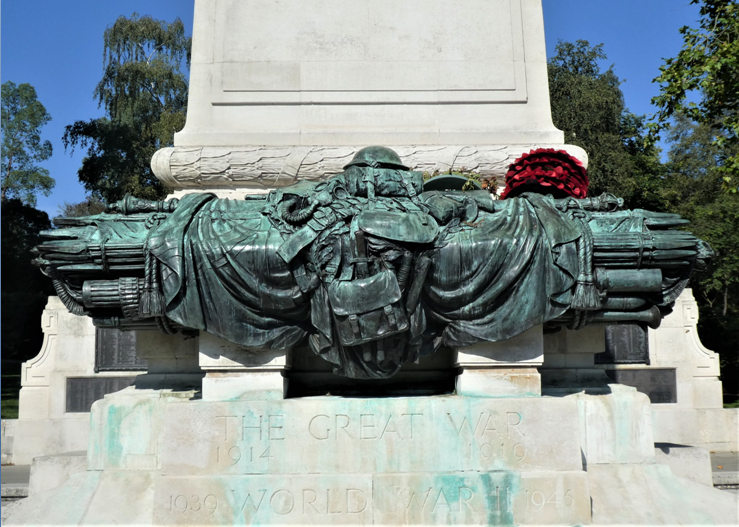
Above: Cenotaph, Christchurch Park
Moving to more recent times, the last quarter of the 20th Century saw an upsurge in the interest and provision of sculpture and public art features in cities and towns around the world. This resulted from a growing awareness of the importance of such features, not only to the general enjoyment of public spaces and the well-being of the public, but perhaps of equal importance to developers, the increased value given to their new buildings and spaces by the addition of a works of art. The general provision of public art was accepted as being an integral part of the ‘placemaking’ initiative being pursued by planners and architects.
In 1988, the Arts Council launched an initiative to encourage local authorities to adopt a ‘Percent for Art’ policy relating to new developments. In Britain, local authorities are not empowered to require developers to contribute a specific budget to art but can recommend that public art be included as an item planning gain in negotiations and this has generated considerable interest in the provision of such works in our centres.
In 1989, the British American Arts Association held a 3-day Symposium in Glasgow, entitled Arts and the Changing Cities. In the preface to the Symposium’s findings report, the then UK Minister for the Arts, the Rt. Hon Richard Luce MP, stated:-
‘The arts – all of them – have a vital part to play in improving the quality of life in the cities of the United Kingdom as in the United States. We must not look on the arts as just an optional extra: they must be an integral part of any strategy for urban regeneration. While the economic impact of the arts on cites was a topic of discussion throughout the symposium, and rightly so, we must remember that the arts are most important because they enrich the quality of life.’
In 1993, the University of Westminster produced a report entitled Public Art in Private Places: Commercial Benefits and Public Policy. In the report’s Executive Summary, it was stated that ‘the main objectives of the research were to assess the commercial benefits on investment for developers and investors in public art provision and to investigate the extent of public policies pertaining to the topic’.
One of the findings of the study was that ‘the research as a whole would support the view that investment in public art is worthwhile in the medium to long term in commercial office developments. Developments endowed with art installations as part of their overall image are likely, provided factors of rent, location and quality of accommodation are equal, to have a competitive edge over their rivals’.
Ipswich was no exception to this increase in the provision of public art since the 1980s but, in our case, I feel that this surge in interest was, generally, a desire to improve the street scenes of our town as much as developers wishing to capitalise upon their investment.
As illustrated by the Borough Council’s leaflet Artathon, produced in 2012, almost forty sculptures and pieces of public art appeared in Ipswich between 1990 and 2011. Of these, fifteen are in the town centre and a further six in the Waterfront area (excluding those pieces located inside buildings). Although each of these pieces of public art has its own story to tell, I will concentrate on a small number from the last forty or so years which I particularly enjoy.
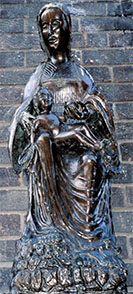
1990 – Madonna and Child (Lady Lane and St Mary Elm Church)
The Marymana Group commissioned local sculptor, Robert Mellamphy, to produce a Madonna and Child piece, based upon the 12th century sculpture originally located in a nationally-important shrine in Lady Lane. Unfortunately, the original sculpture was sent to London to be burnt as part of the Reformation but, along with many people, I believe that it survived and was smuggled out of the country and now resides in a large chapel fronting the beach in Nettuna, Italy. The piece is on the wall in Lady Lane close to where the Shrine was located. Robert also carved a larger wooden Madonna and Child, also based upon the statue in Nettuna, which can be seen inside St Mary Elm Church.
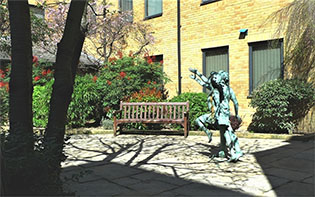
1990 – Spirit of Youth, by John Rivera
Provided by a locally-based developer, Churchmanor Estates, this sculpture brings to life a small space formed in the 1990s by a group of new buildings, situated between Museum Street and Black Horse Lane. I consider that the space, with its delightful sculpture, to be one of the most charming additions to our town centre and understand that the developer commissioned it in order to further beautify this new intimate courtyard provided by his commercial investment. A nice touch was the fact that the piece originally included the girl’s broad-brimmed hat lying separately on the nearby seat but, unfortunately, one night it disappeared.
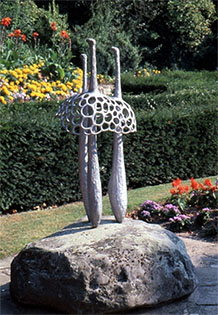
1992 – Triple Mycomorph (Fungus Form)
For me this sculpture has a particularly poignant story. Tom Gondris, whom we lost some two years ago, was for many years an important Borough Councillor who was also keen to introduce more works of art into our town. This sculpture, however, has a strong link to Tom’s own story. He was one of the last children who came to Britain from the then Czechoslovakia via the Kindertransport, organised by Nicholas Winton. Tom was expecting his parents to follow him later but, sadly, that did not happen and he never saw them again. Tom asked his friend and local sculptor, Bernard Reynolds, to create a piece in memory of his parents which is now located in the peaceful garden behind Christchurch Mansion. It can be viewed as representing new life emerging from the old, or as inspired by ballet dancers, which I understand, was one of Tom’s loves, but I see Mother, Father and Child.
1993 – Giles Family, by Miles Robinson (see the photograph on page 2)
Derek Warsop, another long-serving Borough Councillor keen on introducing works of art into the town’s public realm, and Randall Bevan, then Director of Leisure at the Council, approached Daily Express Newspapers, for whom the cartoonist worked, and persuaded them to fund what is, probably, the most popular statue in Ipswich town centre – Grandma and some of the Giles family. It was placed in its original location in 1993 but moved some ten years later when the layout of the space was being remodelled. By this time the space had been renamed Giles Circus after the cartoonist, who had been voted the nation’s favourite cartoonist of the 20th Century. I remember that Bob Kindred and I had to be on site at the time to ensure that, in her new position, Grandma is still grinning (or is it grimacing) up at the window where the cartoonist had his office for many years.
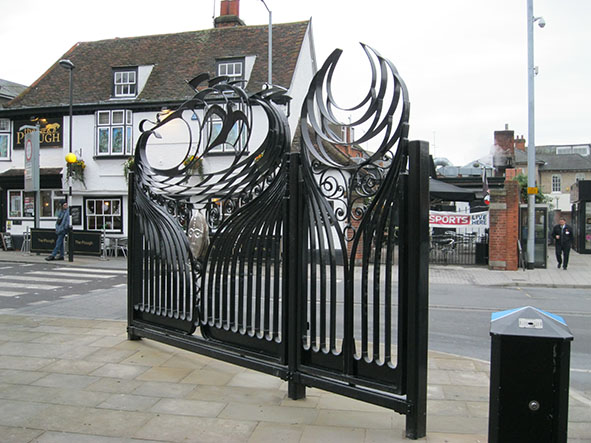
1995 – Longship Screens, by Antony Robinson

1995 – Tam
A year or so after the Giles statue was first erected, I was walking with friends in Rendlesham Forest and passed by the studio of the sculptor, Honoria Surie, and noticed in the garden the Tam sculpture. I was immediately taken with it and felt that we should try to find a good home for her in the town centre. I mentioned all this to Derek Warsop; we went to see it and he agreed that we should try acquire it for the town. In financing the Giles statue, Express Newspapers had provided a sum for the sculpture’s future maintenance. Derek approached the newspaper and received their agreement for the money to be used by the Council to acquire her for the town and she was acquired by the Council from these funds. The grass and treed area close to St Mary at the Elms was chosen as a suitably tranquil location for her. My photograph shows Derek with the sculptor and the model, her daughter Tam (who had in the meantime changed from being a devotee of flower power to that of the punk movement).
2011 – Cardinal Thomas Wolsey
Over the years, there was some debate about appropriateness of seeking a statue to celebrate Ipswich’s most famous, or infamous, son. However, it was finally agreed that his importance in the national story was such that the town should properly mark that Ipswich was his birthplace. A number of sculptors were asked to produce ideas for such a sculpture; the judging panel comprised the Council’s Chief Executive, Jim Hehir, Dr John Blatchly, Peter Mortimer and myself.
In choosing the winning submission, by Scottish sculptor David Annand, the panel felt that, although Wolsey was on the international stage both as a senior man of the church and as an important politician on the European stage, we wished to reflect his main link with the town which was education. He was at school here before going to Oxford and towards the end of his life he was building his college in the town. For this reason, the sculpture portrays him as a teacher rather than his other roles, and around the base is inscribed one of his sayings: ‘Pleasure is to mingle with study, so that the child may think learning an amusement rather than a toil’. Regarding its location, although the space in front of St Peters Church would have linked the statue with St Peters, his Collegiate Church, any sculpture would have been dwarfed by the enormity of the adjoining space which is, basically, a very large traffic junction creating noise and pollution.
Its chosen location at the top of St Peters Street is close to where he was brought up as a child. In addition, towards the end of his life Wolsey was in the process of acquiring Curson House, which fronted the space now occupied by the statue, from Lord Curson. This did not materialise as he fell from grace but by placing the statue there Wolsey was, in effect, coming home.
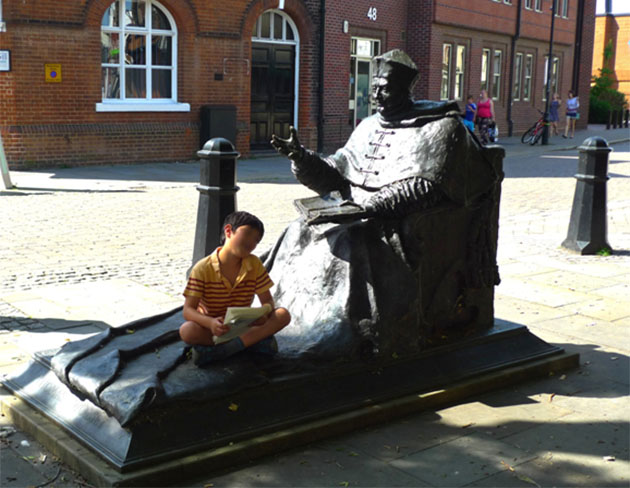
I have chosen a fortuitous photograph I took one day whilst passing, which beautifully encapsulates Wolsey’s belief that education should be made pleasurable as well as informative, with the child appearing to be totally enthralled by what the Cardinal is saying.
2011 – Question Mark, Ben Langlands & Nikki Bell [See the photograph on page 15.]
Somehow this striking sculpture placed close to the University’s Waterfront Building, encapsulates the valuable concept of seeking knowledge and learning through questioning. Its scale allows it to command the space and, now, helps to link the town’s major centre of education to the recent addition, The Hold: Suffolk’s new archives building which, itself, provides a further important centre of learning in Ipswich. The piece also provides an interesting and thoughtful point of interest in the waterfront area – in an area of Ipswich which, I feel, is fast becoming one of the most exciting and stimulating visitor destinations in our region.
John Field – Chair, Ipswich Heritage Forum [John provided most of the photographs.]
[The Society’s Guide to public art in Ipswich accompanies this issue of the Newsletter. –Ed.]